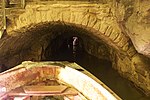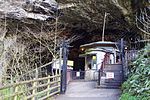Titan (cave)

Titan is a natural cavern near Castleton in the Derbyshire Peak District, and is the deepest shaft of any known cave in Britain, at 141.5 metres (464 ft). The existence of Titan was revealed in November 2006, following its discovery on 1 January 1999 after cavers discovered connections from the James Hall Over Engine Mine to both Speedwell Cavern and Peak Cavern. Previously, the deepest known underground shaft in Britain had been Gaping Gill on the slopes of Ingleborough in the Yorkshire Dales. A group of Peak District cavers discovered the shaft after finding an account by an 18th-century academic, James Plumtree, in a university library. Initial explorations in the James Hall Over Engine Mine led to the discovery of a large shaft named Leviathan, before further excavations revealed the existence of Titan.
Excerpt from the Wikipedia article Titan (cave) (License: CC BY-SA 3.0, Authors, Images).Titan (cave)
Dirtlow Rake, High Peak Castleton
Geographical coordinates (GPS) Address Nearby Places Show on map
Geographical coordinates (GPS)
| Latitude | Longitude |
|---|---|
| N 53.333358333333 ° | E -1.7932916666667 ° |
Address
Titan Shaft
Dirtlow Rake
S33 8WU High Peak, Castleton
England, United Kingdom
Open on Google Maps











